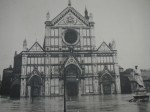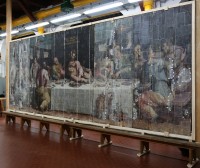In 1546, the Florentine Murate Convent commissioned painter and art historian Giorgio Vasari to make a monumental painting of The Last Supper. The final panorama was more than 21 feet long and 8 feet tall, made out of five poplar wood panels. Despite its unwieldiness, the painting has lived a peripatetic existence, moving around to various locations until in the early 19th century it settled in Florence’s Basilica of Santa Croce. It was there that it met its greatest foe: the great flood of 1966.
 Just a few blocks from the banks of the Arno and at a lower elevation than much of the rest of the city, Santa Croce was hit first and hit hardest by the flood. The high point of the flood, more than 22 feet, was in the Santa Croce area. Water flooded the church’s cloister, the crypt and the Museo dell’ Opera in the refectory. In addition to the Vasari Last Supper, the museum held one of the great masterpieces of 13th century art, the Crucifix by Cimabue, one of only three surviving crucifixes by the artist whose break from the stylized conventions of Italo-Byzantine design was a major influence on the Renaissance humanists that would follow him. It was flooded to Christ’s halo.
Just a few blocks from the banks of the Arno and at a lower elevation than much of the rest of the city, Santa Croce was hit first and hit hardest by the flood. The high point of the flood, more than 22 feet, was in the Santa Croce area. Water flooded the church’s cloister, the crypt and the Museo dell’ Opera in the refectory. In addition to the Vasari Last Supper, the museum held one of the great masterpieces of 13th century art, the Crucifix by Cimabue, one of only three surviving crucifixes by the artist whose break from the stylized conventions of Italo-Byzantine design was a major influence on the Renaissance humanists that would follow him. It was flooded to Christ’s halo.
Santa Croce remained under water for more than 12 hours, longer than anywhere else, saturating wood panel paintings like the Cimabue and Vasari’s Last Supper. Things only got worse when the waters receded. The muddy water, thick with debris, diesel oil, naphtha and sewage, dragged paint off the surface of art works (the Crucifix lost 60% of its paint; staff literally sifted through the water and mud to recover any fragment of the original paint they could) and coated it with scum. The wood under Vasari’s painting was the consistency of a sponge after its 12 hours underwater. The primer layer of gesso underlying the painted surface absorbed so much water that the paint lost adherence and began to peel and flake.
 In order to dry The Last Supper as quickly as possible, museum staff had to separate the five panels making up the piece and coat the surface with rice paper to keep the paint attached. Even so, the wood contracted as it dried and the surface cracked in multiple places. It took restorers 10 years to put the Cimabue back together again. The Vasari was so devastated they didn’t even try. They stored it in a cool place with controlled humidity and just waited until the technology and funding made conservation possible.
In order to dry The Last Supper as quickly as possible, museum staff had to separate the five panels making up the piece and coat the surface with rice paper to keep the paint attached. Even so, the wood contracted as it dried and the surface cracked in multiple places. It took restorers 10 years to put the Cimabue back together again. The Vasari was so devastated they didn’t even try. They stored it in a cool place with controlled humidity and just waited until the technology and funding made conservation possible.
 It was a long wait. A 44 year wait, to be precise. In 2010, the Getty Foundation awarded a $400,000 grant to Florence’s prestigious restoration institute, the Opificio delle Pietre Dure, to conserve The Last Supper and train a new generation of panel-painting conservators to replace the current generation who are due to retire within a decade. Unlike canvas painting restorers, panel work requires a detailed understanding of carpentry and the function of wooden supports. Two experts, Ciro Castelli and Mauro Parri, came out of retirement to work on this project. The former began working as a conservator a few months after the flood and he personally participated in the efforts to stabilize and conserve some of the most damaged paintings.
It was a long wait. A 44 year wait, to be precise. In 2010, the Getty Foundation awarded a $400,000 grant to Florence’s prestigious restoration institute, the Opificio delle Pietre Dure, to conserve The Last Supper and train a new generation of panel-painting conservators to replace the current generation who are due to retire within a decade. Unlike canvas painting restorers, panel work requires a detailed understanding of carpentry and the function of wooden supports. Two experts, Ciro Castelli and Mauro Parri, came out of retirement to work on this project. The former began working as a conservator a few months after the flood and he personally participated in the efforts to stabilize and conserve some of the most damaged paintings.
 Seven conservators of varying experience have been learning from and collaborating with the old pros. Together they worked out a structural solution based on Vasari’s original innovative support structure. Because the cloistered sisters of the Murate Convent did not want Vasari and his assistants working among them for however long it would take them to finish the piece, Vasari was compelled to make the panels portable and joinable. One of his unusual cross-supports is still in place. This served as a model for the conservation team who were able to stabilize the panels and rejoin them for the first time in almost 50 years.
Seven conservators of varying experience have been learning from and collaborating with the old pros. Together they worked out a structural solution based on Vasari’s original innovative support structure. Because the cloistered sisters of the Murate Convent did not want Vasari and his assistants working among them for however long it would take them to finish the piece, Vasari was compelled to make the panels portable and joinable. One of his unusual cross-supports is still in place. This served as a model for the conservation team who were able to stabilize the panels and rejoin them for the first time in almost 50 years.
 The team also focused on removing the rice paper covering the surface and cleaning the disgusting flood detritus from the paint. They found much to their delight that most of the original paint had survived. The estimated paint loss is 20-30%, which while horrendous is nowhere near as bad as they feared it would be. Conservators even found a previously unknown inscription noting an earlier restoration, like much earlier, like 1594, less than 50 years after The Last Supper was painted.
The team also focused on removing the rice paper covering the surface and cleaning the disgusting flood detritus from the paint. They found much to their delight that most of the original paint had survived. The estimated paint loss is 20-30%, which while horrendous is nowhere near as bad as they feared it would be. Conservators even found a previously unknown inscription noting an earlier restoration, like much earlier, like 1594, less than 50 years after The Last Supper was painted.
Superintendent of the OPD Marco Ciatti:
“The Vasari painting was the last major work damaged in the Florence flood to undergo treatment, and the conservation challenges were so complex that we only recently had the technology to begin treatment. When you consider the condition of the panels when treatment started, the current state of the Last Supper—visible again as a single, monumental artwork—is truly miraculous.”
 Now that the surface has been stabilized, the flaking paint re-adhered, next on the agenda is restoration of the paint. That’s expected to take at least another two years, at the end of which Vasari’s The Last Supper will go back on display, hopefully in time for the 50th anniversary of the flood that almost destroyed it.
Now that the surface has been stabilized, the flaking paint re-adhered, next on the agenda is restoration of the paint. That’s expected to take at least another two years, at the end of which Vasari’s The Last Supper will go back on display, hopefully in time for the 50th anniversary of the flood that almost destroyed it.